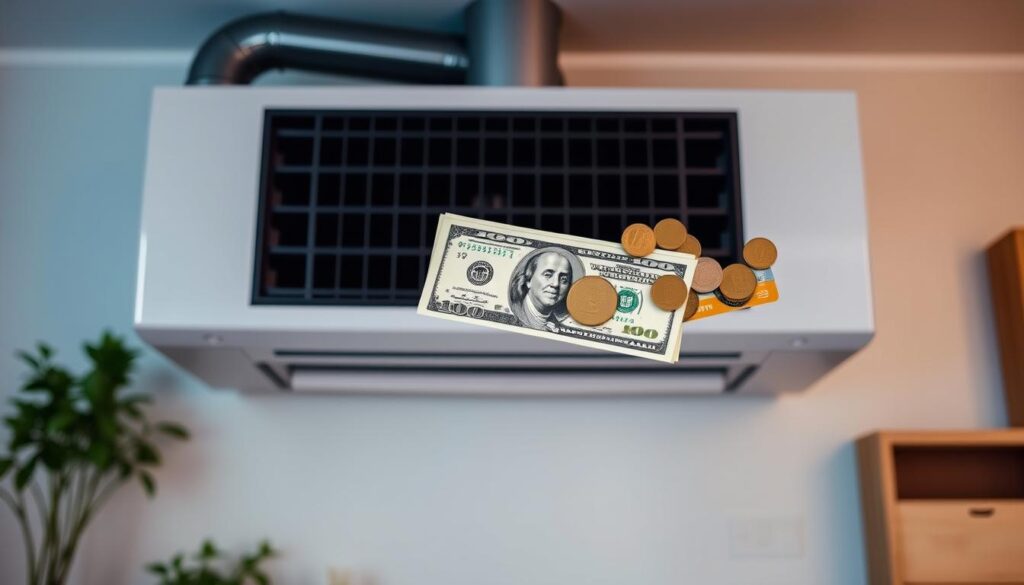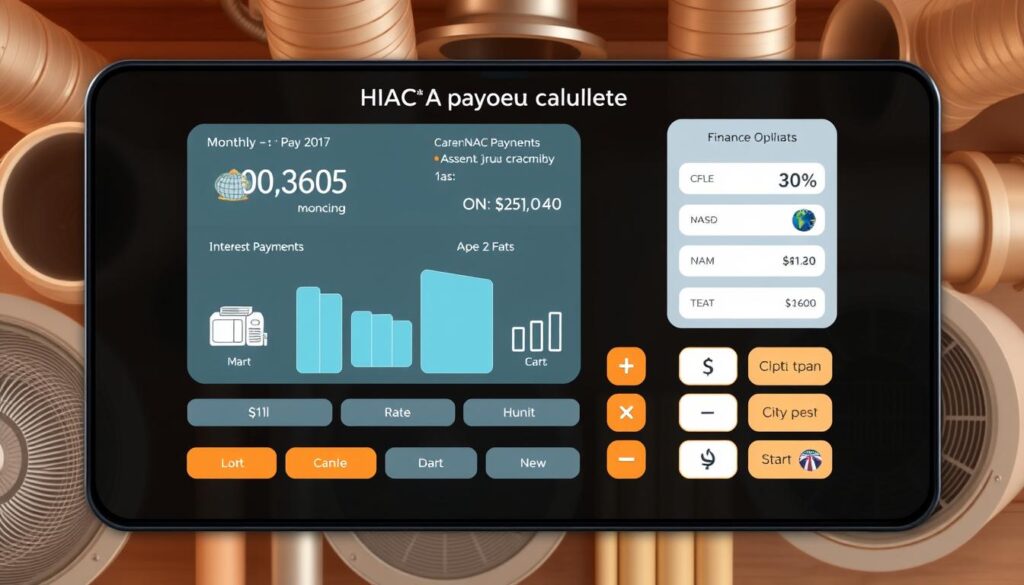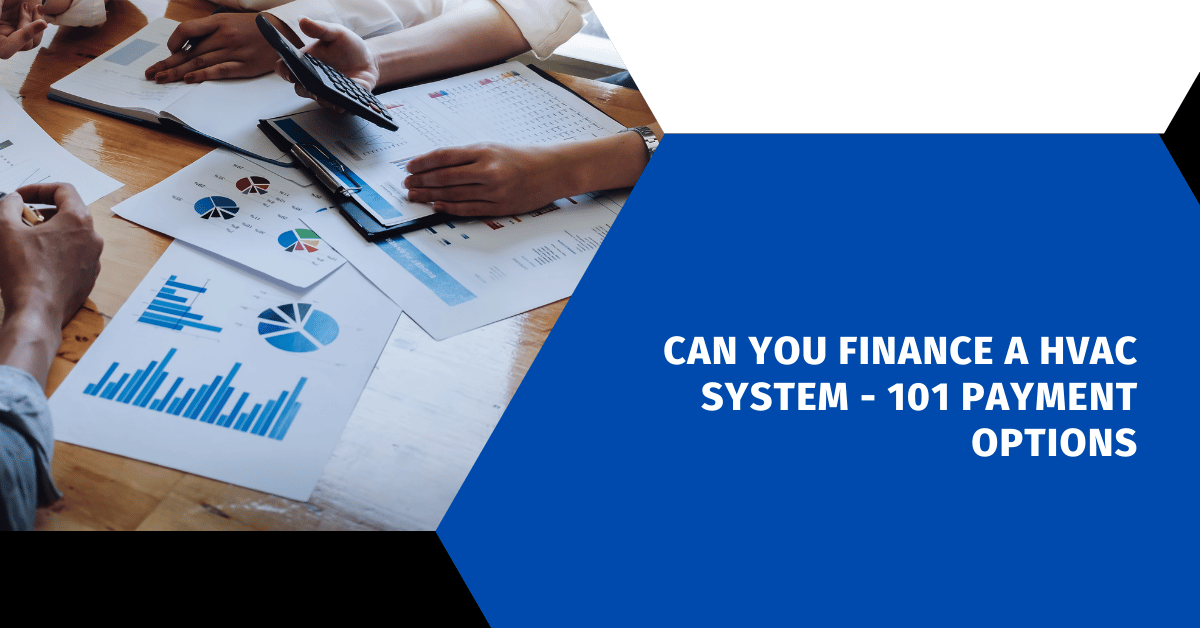Affiliate Disclosure
HVAC Guide Guys is a participant in the Amazon Services LLC Associates Program, an affiliate advertising program designed to provide a means for sites to earn advertising fees by advertising and linking to Amazon.
Can You Finance a HVAC System? Upgrading or replacing your home’s HVAC system can be expensive. The average homeowner might not have thousands of dollars for a new furnace, air conditioner, or heat pump. But, there are financing options to make it more affordable.
Sarah, a recent homebuyer in Denver, faced this challenge. Her old furnace broke down, and she needed a new one for the cold winters. She found financing through her local Trane dealer, using special offers and tax credits.
Many homeowners are looking for ways to finance their HVAC upgrades. Options include personal loans, home equity lines of credit, and manufacturer-backed programs. It’s important to understand each option’s pros and cons to find the best fit for your finances.

Key Takeaways
- HVAC system replacement can be costly, but financing options are available to make it more affordable.
- Factors to consider when choosing an HVAC financing option include credit score, total system cost, and financial implications.
- Rebates and tax credits can help reduce the final cost of HVAC installation.
- Promotional financing offers, such as zero-interest periods, can provide significant savings.
- HVAC companies, banks, and credit unions offer various financing solutions for homeowners.
Table of Contents
Understanding HVAC Financing Basics
Upgrading or replacing your home’s HVAC system can be expensive. HVAC financing helps homeowners spread out payments. This makes the process easier to handle.
What is HVAC Financing?
HVAC financing offers loan and payment plans for new HVAC systems. It lets you pay over time instead of all at once.
Benefits of Financing Your HVAC System
- Immediate system installation: HVAC financing lets you install a new system right away.
- Potential energy savings: New systems can cut energy costs, saving you money over time.
- Improved home comfort: A good HVAC system makes your home more comfortable.
Common Eligibility Requirements
To qualify for HVAC financing, your credit score, income, and debt matter. Lenders look at your credit score, income, and how much debt you have. They might want a credit score of 580 to 660 and an income of $12,000 to $35,000. They also check your debt-to-income ratio, which could be 50% to 75%.
| Eligibility Criteria | Range |
|---|---|
| Credit Score | 580 – 660 |
| Annual Income | $12,000 – $35,000 |
| Debt-to-Income Ratio | 50% – 75% |
Learning about HVAC financing helps you find the right option for your budget. It makes upgrading or replacing your HVAC system easier and more affordable.
Determining the Cost of a New HVAC System Installation
The cost of a new HVAC system varies a lot. It depends on the system’s size, type, and how complex the installation is. The HVAC installation cost, system pricing, and overall estimate will change based on these factors.
Homeowners usually spend between $2,400 and $7,000 for a new HVAC system. This price includes the unit, labor, disposal fees, and any ductwork changes. For an exact cost, talk to a professional HVAC contractor who can check your home’s needs.
Many HVAC companies offer financing to help with the cost. You can also get rebates from manufacturers and tax credits from the government. Some states and utility providers give extra incentives for energy-efficient systems, lowering the HVAC installation cost.
Remember, a new HVAC system saves money in the long run. It improves energy efficiency and cuts down on utility bills. Even though it might seem expensive at first, the savings over time make it a good investment.
To get the best HVAC installation cost and system pricing for your home, work with a trusted HVAC contractor. They can give you a detailed estimate for your needs. They can also help find financing options to make the process easier.
Explore Our HVAC Shop
Looking for top-rated HVAC tools, parts, and accessories? Visit our shop and find the perfect solution for your needs.
Visit the ShopAvailable HVAC Payment Options Today
Homeowners have many HVAC financing options to choose from. These include personal loans, home equity, and manufacturer programs. Each has its own benefits and drawbacks. Knowing these can help you pick the right choice for your budget and goals.
Personal Loans and Bank Financing
Personal loans from banks or credit unions offer fixed rates and set payments. They have terms from 12 to 84 months. This lets you pick a payment plan that suits you.
Home Equity Loans and HELOCs
Home equity loans or HELOCs use your home’s value. They might have lower rates than other HVAC financing options. But, they also risk losing your home if you can’t pay.
Manufacturer Financing Programs
Many HVAC makers, like Carrier, have financing deals with banks. These deals offer good rates and flexible payments. The application is often fast, with approvals in seconds.
It’s key to look at the details of any HVAC financing option. Make sure you understand the terms, rates, and costs. This ensures you’re choosing the best for your home and wallet.
Can You Finance a HVAC System Through Credit Cards
Credit cards can be a good way to finance a new HVAC system. They might not be the cheapest option in the long run. But, they can help with the upfront costs, especially during 0% APR promotions.
Many HVAC companies offer special credit cards for financing. For example, the Wells Fargo Home Projects credit card has 0% APR for 60 months on HVAC purchases. These cards are great for homeowners who can’t pay cash upfront.
But, there are downsides to using credit cards for HVAC financing. Their interest rates are often higher than other loans. Also, if the 0% APR offer ends, the rates can jump up, making the system more expensive over time.
| Financing Option | Average Interest Rate | Typical Repayment Term |
|---|---|---|
| Personal Loan | 6% – 36% | 2 – 7 years |
| Home Equity Loan/HELOC | 3% – 20% | 5 – 15 years |
| Credit Card | 14% – 24% | Varies |
When looking at credit card financing for your HVAC credit options, read the fine print carefully. Compare it to other financing choices. Make sure you can pay off the balance before the 0% APR offer ends. This way, you can avoid high-interest rates and keep your HVAC investment affordable.
Explore Our HVAC Shop
Looking for top-rated HVAC tools, parts, and accessories? Visit our shop and find the perfect solution for your needs.
Visit the ShopSpecial Zero-Interest HVAC Financing Offers
Upgrading or replacing your HVAC system can be easier with zero-interest financing. These offers let you make payments without interest for 12 to 60 months. This makes big HVAC purchases more affordable for homeowners.
Understanding Promotional Periods
Zero-interest financing deals have specific promotional periods. It’s important to know the terms and conditions. If you don’t pay off the balance before the period ends, you’ll face interest charges. Always review the details and plan to pay off the balance on time.
Requirements for Zero-Interest Approval
To get zero-interest HVAC financing, you usually need a good credit score, 690 or higher. This shows you can handle the payments. Some HVAC companies or their financial partners might also have extra rules, like a minimum purchase or specific products.
For instance, Trane offers 0% APR for 60 months with equal payments on their systems. This deal is only available through certain Trane dealers. It’s thanks to their partnership with Wells Fargo Bank, N.A., which has offered flexible financing since 2009.
The Lowe’s Advantage Card also has a zero-interest HVAC financing offer. It’s for purchases or orders of $299 or more, from February 1, 2023, to January 31, 2024. But, interest will apply if you don’t pay in full within 12 months.
If you’re looking for a new HVAC system or an upgrade, check out these zero-interest financing deals. They can help make your investment more affordable and easier to manage.
Explore Our HVAC Shop
Looking for top-rated HVAC tools, parts, and accessories? Visit our shop and find the perfect solution for your needs.
Visit the ShopFinancing Options for Low Credit Scores
If you have a low credit score, getting HVAC financing might seem tough. But, there are ways to get help. Look into these financing options made for people with lower credit scores:
- Secured Loans – These loans need something valuable as collateral, like a car or home. This makes them easier to get for those with bad credit.
- FHA Title I Loans – The Federal Housing Administration backs these loans. They help with home improvements, like new HVAC systems, with easier credit rules.
- Lease-to-Own Programs – Companies like Microf offer lease-to-own deals. They have simple applications and quick answers, helping those with past money troubles.
Also, some HVAC companies have their own financing plans. These plans might be more open to people with bad credit. So, ask about these when you’re looking for bad credit HVAC financing and low credit score options.

Even with a low credit score, you might still find the right financing for your HVAC needs. By looking into these other options, you can get the cooling or heating system you need. Your credit score shouldn’t stop you.
HVAC Company Direct Financing Programs
Many homeowners face a big challenge when buying a new HVAC system. The upfront cost can be too high. Luckily, HVAC company financing programs offer a helpful solution. These direct financing options from HVAC providers make buying easier and more affordable.
Application Process
Getting HVAC company financing involves sharing personal and income details. Sometimes, a soft credit check is needed. This lets the HVAC company check if you qualify for the best financing terms. You can usually apply quickly, with some companies approving you for up to $12,000 right away.
Terms and Conditions
The terms and conditions of HVAC company financing vary. But, they often include:
- Competitive interest rates to help with monthly payments.
- Flexible repayment terms, from 12 to 96 months.
- Potential deferred interest promotions, saving on interest during a special period.
It’s key to read the fine print and compare offers from different HVAC companies. This way, you can find the best deal for your needs and budget.
With HVAC company financing, you can get a new, energy-saving HVAC system without a huge upfront cost. These direct financing programs help make investing in your home’s comfort and efficiency easier.
Explore Our HVAC Shop
Looking for top-rated HVAC tools, parts, and accessories? Visit our shop and find the perfect solution for your needs.
Visit the ShopFederal Tax Credits and Rebates for HVAC Systems
Homeowners can get help with the cost of new HVAC systems through federal tax credits and rebates. The Inflation Reduction Act of 2022 (IRA) offers big savings. You can get up to $2,000 for heat pumps and ductless systems, and up to $600 for furnaces and air conditioners.
To get these credits, your equipment must be ENERGY STAR®-certified. For example, air conditioners need a SEER rating of 16 or higher. Gas furnaces must have an AFUE of 97% or more. The IRA also gives rebates of up to $8,000 for HVAC upgrades through the Home Efficiency Rebates program, and up to $14,000 through the Home Electrification and Appliance Rebates program, based on income and energy savings.
These incentives can make a new HVAC system more affordable. It’s key to remember that these programs are run by states. So, check with your local energy department for details and how to apply.
Utility companies and HVAC makers also offer rebates and discounts on energy-efficient products. By combining these incentives, homeowners can save a lot and make their homes more sustainable.
| HVAC System | Federal Tax Credit | Efficiency Requirements |
|---|---|---|
| Air-Source Heat Pump | Up to $2,000 | Varies by region and system type, with specific SEER, EER, and HSPF ratings |
| Central Air Conditioner | Up to $600 | SEER2 rating of 16 or higher |
| Gas Furnace | Up to $600 | AFUE of 97% or higher, ENERGY STAR-certified |
| Oil Furnace | Up to $600 | AFUE of 95% or higher, ENERGY STAR-certified, approved for renewable fuels |
| Biomass Fuel Stove | Up to $2,000 | Thermal efficiency rating of at least 75% |
By using these HVAC tax credits and energy efficiency rebates, homeowners can make their HVAC upgrades more affordable. This helps make our energy future more sustainable.
Calculating Monthly Payments and Interest Rates
Understanding monthly payments and interest rates is key when financing your HVAC system. Online HVAC payment calculator tools can give you a quick estimate of your financing terms.
For example, if you need a $10,000 HVAC installation, financing it at 0% APR over 60 months means about $167 monthly. The actual cost will depend on your specific interest rates and cost of ownership.
Payment Calculator Tools
Many HVAC companies and lenders have online payment calculators. You can input the loan amount, interest rate, and term length to see your estimated monthly payments. These tools help you compare financing options and find the best fit for your budget.
Understanding Total Cost of Ownership
When looking at HVAC financing, consider the total cost of ownership. This includes the upfront costs and potential energy savings. A more expensive HVAC unit might be worth it if it saves you a lot on utility bills over time.
| HVAC System Cost | Energy Savings | Financing Terms | Total Cost of Ownership |
|---|---|---|---|
| $5,000 | 30% reduction in energy bills | 0% APR, 60-month term | $5,000 + $500 in energy savings = $4,500 total |
| $8,000 | 40% reduction in energy bills | 5% APR, 72-month term | $8,960 + $800 in energy savings = $8,160 total |
By looking at the total cost of ownership, you can choose the best HVAC financing option for your home and budget.

Explore Our HVAC Shop
Looking for top-rated HVAC tools, parts, and accessories? Visit our shop and find the perfect solution for your needs.
Visit the ShopLease-to-Own HVAC Options
If you can’t use traditional financing, lease-to-own HVAC programs are a great choice. They let you rent an HVAC leasing system. You can then own it outright with a rent-to-own air conditioning deal.
Big names like Lennox, Amana, Carrier, Trane, and Goodman are part of these programs. You’ll need to pay between $300 to $500 upfront. The lease term can be from 12 to 48 months, giving you options to match your budget.
Getting into these rent-to-own HVAC plans is easy. You’ll get approved in minutes. You just need to show you can pay, have a mortgage statement, and a voided check for automatic payments. The best part? There are no hidden fees, no credit checks, and payments fit your budget.
Lease-to-own HVAC lets you enjoy energy-saving systems without a big upfront cost. Your monthly payments can be cheaper if you pay by ACH. You also get early payoff options. Plus, the approval process is quick and easy, so you can get your system fast without a lot of paperwork or credit checks.
Need a new HVAC system for an emergency or just to upgrade? Lease-to-own might be the answer. These plans offer flexible terms, easy qualification, and a path to owning your system. They help you stay comfortable at home while keeping your budget in check.
Comparing Different HVAC Financing Solutions
Homeowners have many options when financing a new HVAC system. You might be looking for HVAC financing comparison or the best financing options. Knowing the pros and cons of each can help you choose wisely.
HVAC financing through your contractor is a common choice. These plans last several years and might have low or no-interest options. The approval is quick, and you pay the lender, not the HVAC company.
Personal loans offer flexibility. You can pick any HVAC system and contractor. But, the interest rates might be higher than other options.
| Financing Option | Interest Rates | Loan Terms | Advantages | Disadvantages |
|---|---|---|---|---|
| HVAC Contractor Financing | Low or no-interest | Several years | Quick approval, payments to lender | Limited to HVAC company’s financing partners |
| Personal Loans | Higher interest rates | Flexible | Choose any HVAC system and company | May have higher interest rates |
| Home Equity Loans/HELOCs | Lower interest rates | Longer terms | Larger loan amounts, lower rates | Home is used as collateral |
| Credit Cards | Higher interest rates | Short-term | Earn rewards or cashback | High-interest rates if not paid off quickly |
Home equity loans or lines of credit (HELOCs) often have lower interest rates. They are secured by your home and can offer larger loan amounts if needed.
When looking at HVAC financing solutions, think about interest rates, loan terms, and monthly payments. Also, consider the total cost of ownership. By looking at your credit score, home equity, and financial goals, you can find the best option for you.
“A difference of just a percent or two in interest rates from lenders can significantly impact the overall cost of HVAC financing.”
Conclusion
Financing a new HVAC system is a big decision. You need to think about the cost, your credit score, and your options. It’s important to know the long-term effects and terms of each choice.
Don’t forget to consider the energy savings, tax credits, and rebates. These can help lower the cost of a new HVAC system. Talking to different HVAC experts and financial advisors can help you pick the best HVAC financing decision and choosing the right option for you.
Looking at the good and bad of each financing option helps you make a smart choice. This choice should fit your budget, energy goals, and financial future. With the right plan, you can get a new, efficient HVAC system without breaking the bank or feeling overwhelmed.

